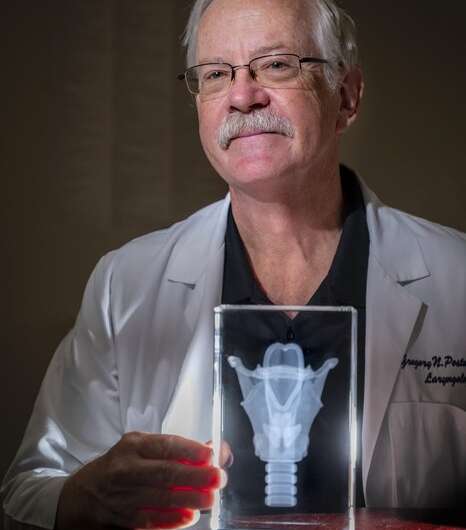
Smaller is better when it comes to the flexible plastic endotracheal tubes placed in the windpipe to help patients breathe, say the medical professionals who treat vocal professionals.
Endotracheal tubes, which come in a wide range of sizes, are placed in a process called intubation in ICU and trauma patients as well as in individuals requiring general anesthesia for a variety of surgical procedures.
Objective data is scarce on just what precautions should be taken in managing the airways of professional voice users in particular, which can include a wide range of individuals from actors to educators, so they asked the experts what they do, Dr. Gregory N. Postma, director of the Center for Voice, Airway and Swallowing Disorders at the Medical College of Georgia at Augusta University, and his colleagues report in the Journal of Voice.
“The majority of voice surgeons taking care of vocal professionals want to use smaller tubes,” says Postma, senior author on the study, which included investigators from Beth Israel Deaconess Medical Center in Boston and the University of Kentucky College of Medicine in Lexington.
Problems with intubation include shorter-term issues like trouble speaking and a sore throat while longer-term or mishandled intubations can result in ulcers, impaired mobility of the vocal cords, narrowing of the windpipe, even perforation of the esophagus, which is right behind the windpipe, says Postma, who regularly provides consultation for temporary and chronic voice problems that can result from intubation.
While these types of deleterious effects are unwanted in any patient, they can be particularly devastating in singers, the investigators write.
Their 21-item survey of members of the American Broncho-Esophagological Association, European Laryngological Society and attendees to the Fall Voice Conference, an annual, professional multidisciplinary conference, was the largest to date on precautions taken in the airway management of male and female professional voice users.
The 147 practitioners responding said that in addition to picking a smaller size tube, practitioners experienced in the care of the voice are the best choice for taking care of these patients. Fourteen percent said they personally intubate their patients more than 90% of the time and of those who help train residents, over 60% don’t permit the trainees to intubate these individuals. The majority also said they would manage the airway of a non-singer the same way.
Respondents were largely laryngologists along with a small percentage of general otolaryngologists and head and neck oncologists, most of whom said they regularly take care of vocal professionals.
The investigators say they hope the survey results will restart a dialogue between anesthesiologists, who most typically perform an intubation, particularly in the operating room, to establish more evidence-based practices for this “highly specialized patient population.”
More questions also need to be asked to further elucidate best practices, they say. The Laryngology team of surgeons and speech pathologists at MCG and the AU Health System is working with colleagues in the MCG Department of Anesthesiology to survey anesthesiologists across the country about their practices in managing voice patients. And, they are working with other leaders in voice care at Vanderbilt University in Nashville, Mount Sinai Hospital in New York City, Johns Hopkins University in Baltimore and the University of Southern California in Los Angeles to develop a consensus document to help standardize best practices in their select field.
Postma’s patients include professional and amateur singers, clergy, school teachers and college professors, as well as automobile and real estate salespeople. Professional singers particularly can have problems with overuse, and can experience further damage by not giving their voice adequate time to rest and recover, he says.
He notes at MCG, Georgia’s public medical school, and the AU Health System, there is an experienced team that includes speech pathologists, members of the MCG Department of Anesthesiology and Division of Pulmonology, Critical Care and Sleep Medicine, who work with voice professionals, and a movement toward using smaller endotracheal tubes for a variety of patients, regardless of their vocation, in settings like ICUs and the Emergency Department. Similar trends are developing in other parts of the country and a consensus document should help grow the positive trend, he says.
Endotracheal tubes range from 2.0 millimeters, a size often used for premature infants, to 12 millimeters and are placed between the vocal cords in the larynx, or voice box, which sits on top of the windpipe, or trachea, in the neck.
Source: Read Full Article



